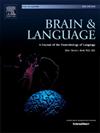Exploring whether and when acquisition order interacts with exposure frequency during lexical learning: Evidence from behavioral and electrophysiological findings
IF 2.3
2区 心理学
Q1 AUDIOLOGY & SPEECH-LANGUAGE PATHOLOGY
引用次数: 0
Abstract
Production and comprehension research has shown that words acquired earlier and encountered more frequently are responded faster and more accurately, reflecting the effects of age of acquisition (AoA) and word frequency (WF). Both effects are interpreted as the quality of lexical-semantic/phonological representations and the structure of lexical network. However, it remains unclear how the processing advantages associated with earlier acquisition and frequent occurrence develop in the vocabulary learning. To address these issues, this study investigated whether and how acquisition order and exposure frequency of to-be-learnt pseudowords, mirroring AoA and WF of real words, affect Chinese spoken word production over four consecutive days. ERP recordings on Day4 further explored the time courses of acquisition order and exposure frequency effects for newly-acquired pseudowords. Results illustrated an overall benefit of earlier acquisition regardless of the degree of consolidation, while higher exposure frequency merely modulated early formation of episodic representations. Moreover, the acquisition order effect was localized to more positive waveforms occurring around 148–578 ms after pictures onset. No interaction was observed between acquisition order and exposure frequency at either behavioral or electrophysiological levels. Our findings therefore have implications for the dominant role of acquisition order over exposure frequency in shaping the development of lexical network in adults.
探索词汇学习中习得顺序是否以及何时与暴露频率相互作用:来自行为和电生理发现的证据
产生和理解研究表明,习得越早、遇到越频繁的词语反应越快、越准确,这反映了习得年龄和词频的影响。这两种影响都被解释为词汇-语义/语音表征的质量和词汇网络的结构。然而,与早期习得和频繁发生相关的加工优势如何在词汇学习中发展尚不清楚。为了解决这些问题,本研究在连续四天的时间里,考察了拟学习假词的习得顺序和暴露频率是否以及如何影响汉语口语单词的生成,这些假词反映了真实单词的AoA和WF。第4天的ERP记录进一步探讨了新习得假词习得顺序的时间过程和曝光频率效应。结果表明,无论巩固程度如何,早期习得都有总体上的好处,而更高的暴露频率仅仅调节了情景表征的早期形成。此外,在图像出现后148 ~ 578 ms左右出现的正波形中,采集顺序效应更为明显。在行为或电生理水平上,没有观察到习得顺序和暴露频率之间的相互作用。因此,我们的研究结果暗示了习得顺序比暴露频率在塑造成人词汇网络发展中的主导作用。
本文章由计算机程序翻译,如有差异,请以英文原文为准。
求助全文
约1分钟内获得全文
求助全文
来源期刊

Brain and Language
医学-神经科学
CiteScore
4.50
自引率
8.00%
发文量
82
审稿时长
20.5 weeks
期刊介绍:
An interdisciplinary journal, Brain and Language publishes articles that elucidate the complex relationships among language, brain, and behavior. The journal covers the large variety of modern techniques in cognitive neuroscience, including functional and structural brain imaging, electrophysiology, cellular and molecular neurobiology, genetics, lesion-based approaches, and computational modeling. All articles must relate to human language and be relevant to the understanding of its neurobiological and neurocognitive bases. Published articles in the journal are expected to have significant theoretical novelty and/or practical implications, and use perspectives and methods from psychology, linguistics, and neuroscience along with brain data and brain measures.
 求助内容:
求助内容: 应助结果提醒方式:
应助结果提醒方式:


